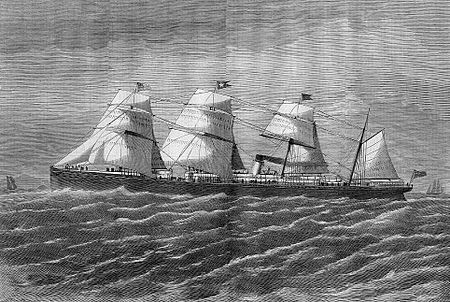"I continue to be amazed by the sheer number – and scale – of shipping disasters in the 19th Century and many have been described previously in this blog. It's notable that in so many cases the "accidents" were avoidable and attention to even the most basic precautions would have averted them. Unwillingness to provide adequate lifeboats was to be a common feature up to the Titanic sinking in 1912, but many other tragedies resulted from sheer bad seamanship. It's also probable that the custom of recruiting crews for short periods – often only a single voyage – mitigated against formation of efficient teams that worked together over long periods. Working and accommodated in often-atrocious conditions, and poorly paid, the merchant-seamen of the period must have had very little identification with their ships. It's notable that in the same era there were relatively few losses in the Royal Navy. On many occasions indeed, naval ships survived conditions that would have doomed civilian vessels, the cohesion, discipline and esprit de corps of the naval crews being worth diamonds in extreme situations.
These musings were prompted by reading a Victorian-era account of the wreck of the 3700-ton RMS Atlantic, a liner belonging to the famed White Star Line which would later own the Titanic. When she came into service in 1871 this ship was one of the fastest and most luxurious afloat. 420-feet long, and driven at a maximum of 14.5 knots by her single-shaft 600-hp engine, she carried auxiliary sails on four masts – the back-up to steam that was still essential in this period. With the "RMS" identifying her as authorised to carry Royal Mail, the Atlantic was employed on the prestigious Liverpool-New York route "with wonderful regularity", and with capacity for 1166 passengers in addition to her crew.
In March 1873 the Atlantic set out on her nineteenth voyage to the United States with 835 passengers – many of them emigrants – and 117 crew on board. Stormy weather was encountered from the start and this caused such heavy consumption of coal that the Atlantic's Captain Williams decided to head for Halifax, Nova Scotia, to replenish his bunkers before pressing on to New York. On the evening of March 31st, the Atlantic was within some dozen miles of Halifax and stormy conditions were continuing. Williams decided to put off entering harbour until daylight and in the meantime the ship was set on a southerly course. retired to his. At midnight he retired to rest in the chart-room, leaving instructions for the officer of the watch to call him at three o'clock. The first officer had apparently also retired, leaving the vessel in charge of the second and third officers. Despite proximity to a dangerous coast, they did not take soundings, or post a masthead lookout, or reduce speed. They failed to spot the Sambro Lighthouse to the south of Halifax's harbour entrance…"

Main page
link
Amicalement
Armand

